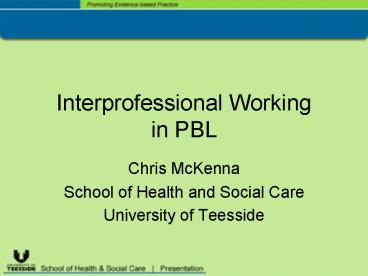Interprofessional Working in PBL - PowerPoint PPT Presentation
1 / 9
Title:
Interprofessional Working in PBL
Description:
Interprofessional Working. in PBL. Chris McKenna. School of Health and Social Care ... Pre reg P/G programmes commenced 2000. OT pre reg P/G commenced Feb 2003 ... – PowerPoint PPT presentation
Number of Views:35
Avg rating:3.0/5.0
Title: Interprofessional Working in PBL
1
Interprofessional Working in PBL
- Chris McKenna
- School of Health and Social Care
- University of Teesside
2
School of Health Social Care
- 5000 students enrolled
- Foundation degrees to Doctoral degrees
- Pre reg P/G programmes commenced 2000
- OT pre reg P/G commenced Feb 2003
3
PBL within the School of Health and Social Care
- Linked to both U/G and P/G
- Used to create more realistic learning
opportunities - Used alongside traditional teaching
- Shared across disciplines
4
PBL in theMSc AHPStudies (OT)
- Learning currently shared across OT, PT and
Diagnostic Radiography - Adult Nursing to become part of the framework
- Cycles last 3 weeks - 2hrs per session
- 2 staff facilitators
5
Previous experience
- Previous undergraduate experience
- Worked on PBL as an individual group
- Worked on multidisciplinary PBL
- Experienced a rapid cycle through induction
6
Implementation
- Group clarified
- Triggers identified
- PBL Cycle early in module
- Joint facilitation across disciplines
- Peer assessment via team developed tool
7
Non Accredited Learning
- Induction week - trigger linked to organising
freshers week social event - Clinical induction - trigger linked to infection
control
8
The Student Experience
- Accepted each others role
- Awareness of professional overlap
- Time allowed opportunity to reduce protective
stance - Viewed selves as team
- Wanted to repeat the experience
- Clarified own professions role
9
Negative Elements
- Inequality in group lead to reluctance in
participation - Grey areas were delegated to larger professional
group - Students were less willing to commence on new
cycle with other professional groups































